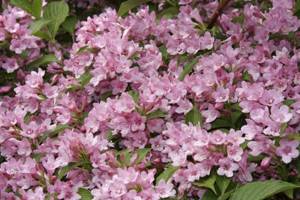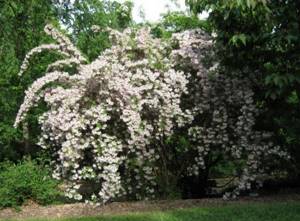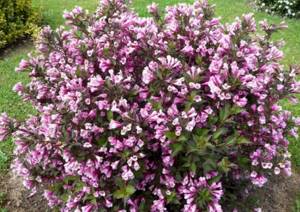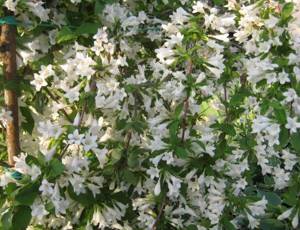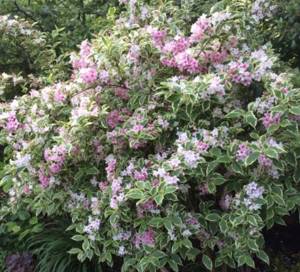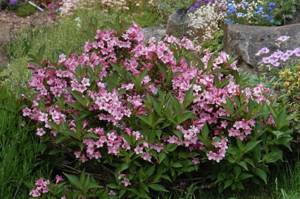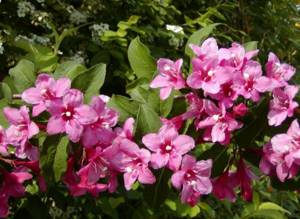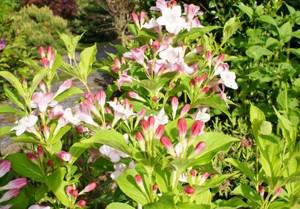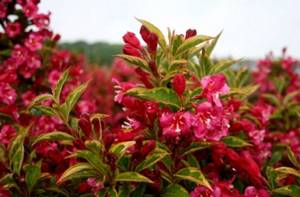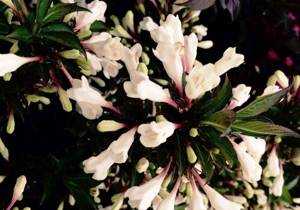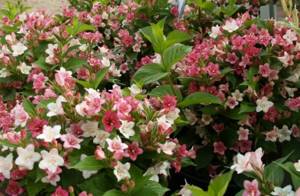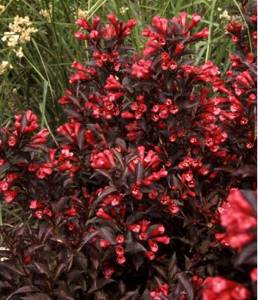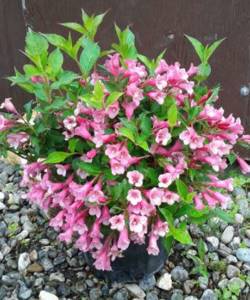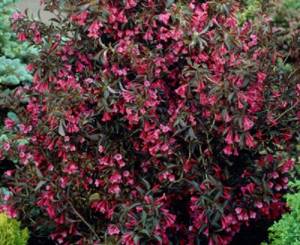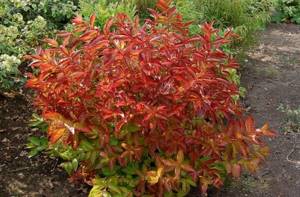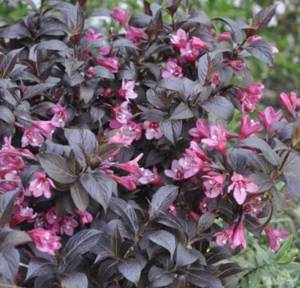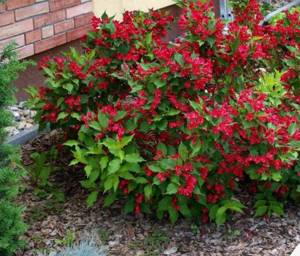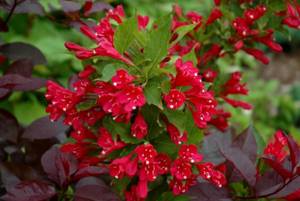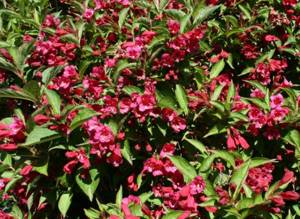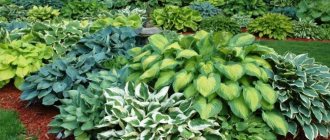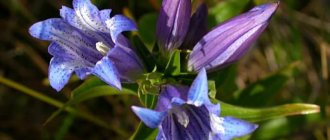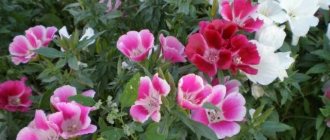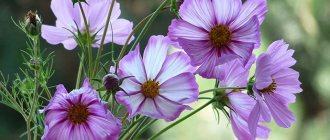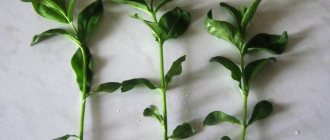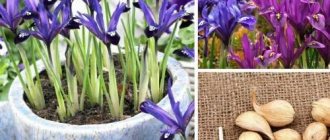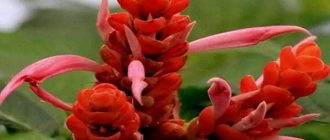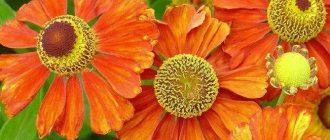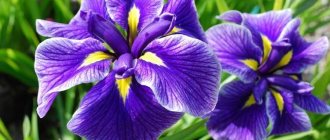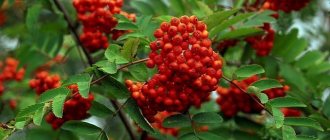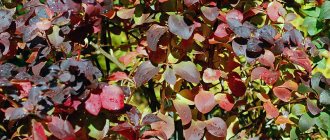Weigela belongs to the deciduous shrubs of the Honeysuckle family. The plant is native to China and Japan. Experts count about 15 types of weigela. The plant received its name in honor of the German scientist Weigel. The deciduous shrub was discovered in the 19th century.
Weigela is an amazing shrub that blooms from May to June, and then from August to September. If you look at the photo of weigela, you can see a gorgeous spreading rose bush.
Weigela will look great on a summer cottage or in a park area. The inflorescences are pale in color at first, then darken.
Planting and care in open ground
Weigela loves sunlight and tolerates light partial shade, you need to take this into account when planting. The plant is protected from gusts of wind from all sides. It is best to use three-year-old weigela for planting. Bushes are planted at a distance of 1.5 meters from each other.

Weigela is planted at a depth of 0.5 meters.
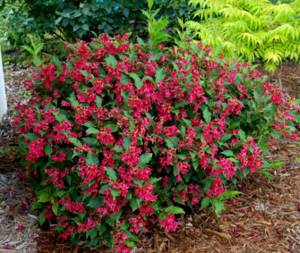
Deigela is a very capricious shrub that may not take root in the fall. The shrub loves well-drained fertile soils and does not tolerate stagnant moisture.
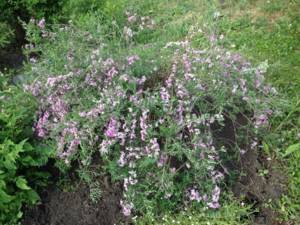
Winter-hardy weigela varieties for the Moscow region and beyond
Thanks to the efforts of breeders, it was possible to develop varieties of weigel that winter well in the central zone of our country. Let us consider below those species and their varieties that can be used for cultivation in the Moscow region and other regions.
Please note that the flowering weigela varieties Alba, Nana Purpurea and Nana Variegata are excellent for Siberia and the Urals.
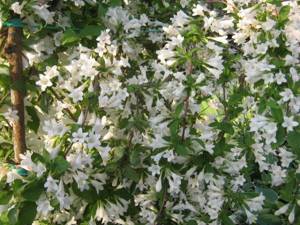
Alba
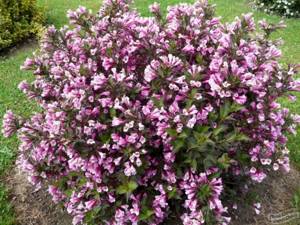
Nana Purpurea
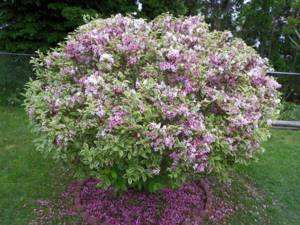
Nana Variegata
Flowering weigela or Florida (Weigela florida) + 19 varieties with photos and descriptions
Grows up to 3 meters. The shoots in two rows are covered with small hairs, and the leaf blade has pubescence along the central vein. Flowering begins at the end of May and lasts no more than three weeks. At this time, the bush is covered with pink flowers, collected in inflorescences of 3-4 pieces.
This species is represented by several varieties, consider them in the table:
| Variety | Characteristic |
| Rosea
| Large bush up to 2 m high and 2.5 m wide. The flowers are large, pink, with a spicate limb, slightly dazzled with white. The leaves are light green, turning red in autumn. Blooms in June. The variety has excellent winter hardiness. |
| Candida
| The bush grows up to 2-2.5 m. The flowers are large, white, collected in loose panicles. The leaves are light green. |
| Purple, red or Nana Purpurea (Nana Purpurea)
| The height of the bush is 1.5 m. The crown is lush. Flowering begins no earlier than mid-June and continues until July. The flowers are an intense dark pink and the leaves have a reddish tint. Perfect if you don't have much space in the garden. |
| Alba
| A low-growing bush about 50 cm in height. It blooms with white flowers that turn pink when withered. |
| Nana Variegata
| It is considered the most frost-resistant weigela. Height up to 1.5 m. Leaf blades are small, green with a cream edging. The flowers are very beautiful, bell-shaped, white and pink. Blooms in June and July. |
| Pink Poppet
| Dwarf bush, spherical crown. Height 0.8 m. Leaves are oblong, pointed, jagged, pleasant green in color. The flowers are soft pink. |
| Pink (Bunge)
| The variety is distinguished by large pink bell flowers (4 cm in diameter). The height of the bush is 1.5 m, the crown is spreading and lush. |
| Victoria
| The height of the bush does not exceed 1 meter, the leaf blades have a brownish-red tint, and the flowers are purple-red, light pink inside. |
| Alexandra
| The bush grows up to 2 m. The leaves have a unique purple color and the flowers are deep pink. |
| Marjorie
| Height 1.2 m. The variety is distinguished by the fact that one inflorescence can simultaneously contain flowers of white, pink and purple colors. The diameter of the flowers is 2-6 cm. It blooms in May-June. The leaves are green, drop-shaped. |
| Brigela or Brigella
| The bush grows up to 2.5 meters, the shoots hang down slightly. The leaves are light green with yellowish veins. The color of the flowers is ruby. |
| Ebony and Ivory
| An ornamental shrub, the height of which does not exceed 0.9 m, width - 0.9-1.2 m. The leaves have a dark purple tint and will appear black from a distance. They are especially effectively set off by the snow-white inflorescences that appear at the beginning of summer. Frost resistance down to -29 ºС. |
| Black and White or Black and White (Black and White)
| A dwarf bush with a rounded crown, 0.3-0.4 m high and 0.6-0.8 m wide. The flowers are white with a carmine-red throat, bell-shaped, there are many of them. The variety blooms in June. The leaves are initially dark green and gradually become plum-purple. They contrast beautifully with the flowers. |
| Carnaval
| Plant height up to 0.7 m. Flowers are white, pink and red (on one bush). Flowering occurs in June-July. |
| Naomi Campbell
| Compact shrub with a dense crown up to 0.9 m high. The flowers are purple-red, the leaves are dark purple-bronze. |
| Pink Princess or Pink Princess
| The height of the variety is 1.5 m. The crown is spreading. The flowers are a pleasant light pink shade. Blooms in May-June. Sometimes it blooms again in August. |
| Ruby Queen
| Height up to 0.8 m. The crown is very dense and branched. The leaves are reddish or copper in early summer, gradually becoming brownish-red, but without the purple tint. In hot weather they change partly to a dark olive green color, but at the tops of the shoots new leaves still grow brownish-red. In autumn they turn shades of bronze. Bell flowers appear in June. They are dark pink in color and become darker as they bloom. |
| Wings of Fire or Wings of Fire
| The height, as a rule, does not exceed 0.9 m. But by 10 years it can reach 1.2 m. The leaves in the spring are green-brown with a reddish or copper tint, in the summer they become light green, and from July they again begin to acquire purple-red shades . The flowers are pink-lilac. Flowering occurs in June-July. |
| Elvira or Elvera
| The height of the bush is up to 0.9 m. The crown is dense and compact. The leaves are dark purple. The flowers are pink. The variety begins to bloom in June, but may repeat in August-September. |
Hybrid weigela (Weigela hybrida) + 3 varieties with photos and descriptions
Grows up to 1.5 meters in height. The crown is spreading. The flowering is abundant and lush, the color of the petals depends on the variety. The following varieties belong to hybrid weigela; we will also consider them in the table:
| Variety | Characteristic |
| Bristol Ruby
| The variety was bred in the USA. A tall shrub that grows up to 2-3 meters. The crown is very lush. The leaf blades are bright green. Flowering begins in May or June, the petals are red with ruby edges, and there are buds with an orange core. Inflorescences abundantly cover the shoots. This variety can be used as a hedge, as the centerpiece of a flower bed, or as a colorful backdrop. Even with the arrival of autumn, the shrub retains its beautiful green foliage for a long time. |
| Red or Red Prince
| Another American variety. It grows up to 1.5 meters, the shoots droop slightly, the crown is lush, the flowers are bright red. The leaves are green and beautiful. The variety can bloom twice per season (in May and August). The leaves do not fall until late autumn. Withstands frosts down to -20 °C. |
| Eva Rathke
| A hybrid between Korean weigela (coraeensis) and abundantly flowering (floribunda). The bush is compact, up to 1.5 m high with a spreading crown (its diameter is up to 3 m). The leaves are light green. The bell flowers are 4 cm in diameter, blood red on the outside and lighter on the inside. Blooms in June-August. |
Early weigela (Weigela praecox) + 3 photos
This species is most often found in natural conditions in the Far East. The height of the shoots can reach 2 meters. The upper part of the leaf blade is covered with fine fluff and yellow specks, which turn creamy in the sun. Inflorescences are formed on the lateral shoots of the current year and consist of 2-3 flowers. Their color is often pink, but sometimes the throat can have a light yellow tint.
The buds begin to bloom in the last week of May, flowering lasts from 1 to 4 weeks.
Weigela suavis + 3 photos
It is a shrub up to 1.5 m high. The leaves are green, bare, pointed, pubescent on the inside, up to 6 cm long. The flowers are pink-violet or lilac-pink, pale pink inside. The species blooms from late May to June, sometimes longer. Possible re-blooming at the end of August.
Variegated weigela (Weigela variegata) + 3 photos
Bush 1.5 m tall. The flowers are pink-red, grow singly or in groups of up to 2-6 pieces. The leaves are green with white edges. It blooms in May-July, sometimes it blooms again at the end of summer.
Weigela middendorffiana + 3 photos
The height is 1-1.5 m, the shoots are erect and ascending. The flowers are large, bright yellow, 3.5-4 cm in diameter. They can be solitary, but most often they are collected in an inflorescence of 3-4 pieces. Under favorable conditions, flowering occurs twice per season. The leaves are large, light green, finely toothed, oval with a pointed tip.
New winter-hardy weigela varieties for central Russia
Breeders are constantly working on new varieties of weigela that can be grown in areas with frosty winters. For example, such new products are:
- Variety All Summer Peach. This is the most compact of all varieties of flowering weigela. It grows no more than 40 cm in length and width. The leaves are bright green, flowering occurs in May-June with peach-white tubular inflorescences. It re-blooms in August-September and is a winter-hardy variety.
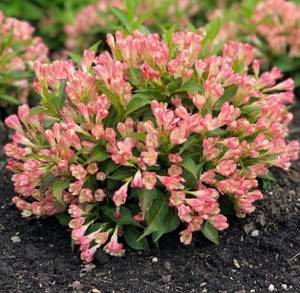
- The Caricature variety, also low-growing, is intended for green borders. It has very unusual twisted thick and large leaves, similar in shape to basil leaves, with a light edging. Pink flowers appear in May-June, August-September. Winter-hardy.
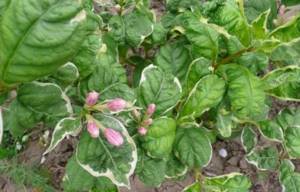
Weigela care
When watering, the weigela bush is loosened and sprinkled with sawdust or peat. Complex mineral fertilizer is applied in the spring and before flowering. To accelerate growth, nitrogen fertilizers are used, and phosphorus-potassium fertilizers are used to enhance flowering. The fertilizer should dissolve with good watering.
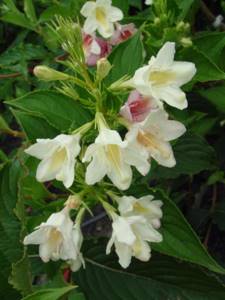
The plant needs rejuvenating pruning every few years. Young shoots are cut in half in the spring.
Diseases and pests
Hybrids of weigela with pink flowers are representatives of the flora that are quite resistant to all kinds of infections and pests. However, if there are errors in care, almost every plant grower faces this problem.
The most common pests on the bush can be found aphids and caterpillars ; during periods of drought, this list can be supplemented by spider mites and thrips . They can be eliminated by spraying the bush with all kinds of complex insecticides (Keltan, Rogor, Nitrafen, etc.).
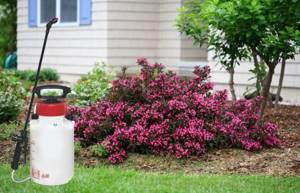
Such procedures are carried out twice, with a gap of 14 days.
Among the infections, weigela hybrids can be affected by rust , gray rot and spotting . To cure a plant, it is enough to spray the shoots with a complex fungicide twice (with an interval of 14 days). The Bordeaux mixture has the broadest effect.
Weigela hybrids with pink flowers are one of the few examples of universal ornamental plants that can successfully fill almost any landscape, becoming its basis or an ideal addition. These varieties are unpretentious and also have good winter hardiness. However, when growing them, the flowerbed should be looked after daily. Only this will help achieve long-term growth of bushes, as well as 2 generations of elegant and unique flowers.
Reproduction
Seeds
When weigela is propagated by seeds, their germination lasts about a year. Amateurs grow weigela at home in flower pots under glass or film. A one-year-old weigela seedling has a length of 6 cm, a two-year-old one is 0.5 m. After the appearance of true leaves, the seedlings dive. You need to grow weigela in the summer at your summer cottage.
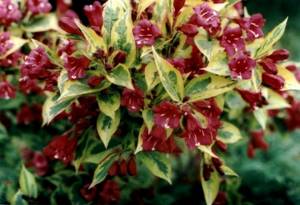
The plant has a fibrous root system and spreads quickly underground. Varieties are best propagated vegetatively. Cuttings are carried out in the first half of summer before flowering begins.
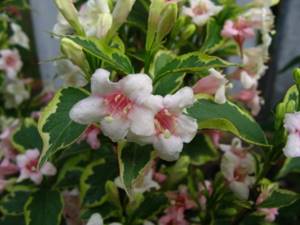
Cuttings
Weigela, propagated by cuttings in summer, blooms after 2 years of age. How is cutting carried out?
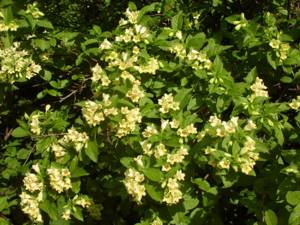
For cuttings, slightly lignified young shoots are used. They should consist of one internode and several leaves.
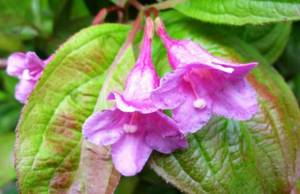
Summer cuttings
- Step 1. Weigela leaves are removed by half or completely.
- Step 2. The cuttings are placed in water for several hours, dipped in root, and kept for half a day in a dark room.
- Step 3. Plant cuttings are planted in the second half of June. The soil should include sand and peat. The weigela cuttings should be in the ground at a depth of about 1 cm. The young cuttings are covered and watered several times a day.
Winter cuttings
Cuttings 20 cm long are also cut in April before the leaves open.
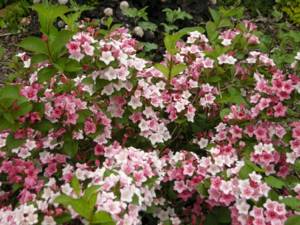
- Step 1. Peat and sand are poured into the pots in a 1:1 ratio. Planting material is treated with root.
- Step 2. After a month, pinching is done and fertilizing is applied.
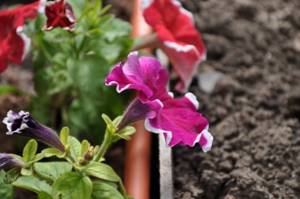
How weigela middendorf blooms
The variety belongs to crops with an average flowering period; a distinctive feature of Middendorf weigela, which makes it attractive to gardeners, is double flowering. The first wave begins at the end of May, the next one in August. Flowering duration is 4 weeks. Therefore, the bushes look aesthetically pleasing all season long.
The first buds form at the top of last year's stems, and at the end of summer on the current year's shoots. Weigela blooms with single large flowers, less often they are collected in inflorescences of 2-3 pieces. The shape is funnel-shaped or tubular in the form of a bell. The color changes during flowering from bright yellow to light lemon. A bright crimson splash in the middle of the throat makes the flower decorative.
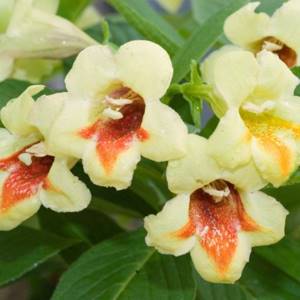
Important! Weigela middendorf blooms without fragrance.
Weigela and landscape design
Weigela bushes are used both in solitary plantings and in groups. Weigela will look great with spirea gray, Japanese, Van Gutta, and willow.
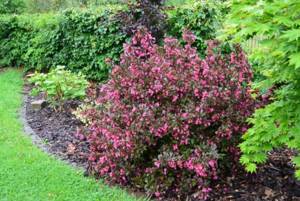
The spreading crown of the bush will be perfectly combined with forms of intermediate forsythia and Japanese chaenomeles.
Weigela hybrids
Hybrid weigela consists of several crossed varieties that are distinguished by color and leaf shape. Hybrids are used in landscape design because they are the most decorative.
Weigel varieties
"Bristol Ruby" Quite tall bushes about 3 m. Dark pink inflorescences, dark green leaves, collected in bunches.
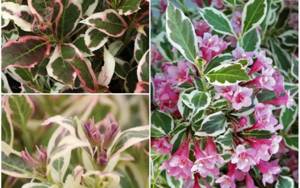
"Eva Rathke" The hybrid comes from Poland. Bush size 2x3 m. Red inflorescences.
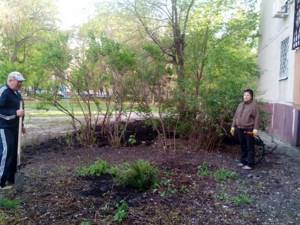
"Weigela Rosea". Shrubs with large pink flowers 1.5 m high. This weigela is also decorative in the fall - the leaves turn scarlet.
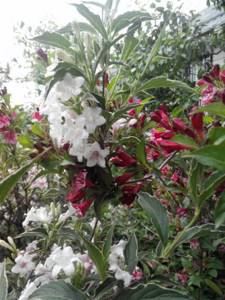
Botanical description of weigela shrub
Weigela is a deciduous shrub. The shoots are erect, their height is from 50 to 200 cm, but some varieties grow up to 3 meters. During growth it does not form stolons. The leaves grow according to the principle of opposite arrangement. The shape is slightly elongated, elliptical, the edges are slightly jagged. The stalk is small.
Depending on the type and growing conditions, the flowers can be single or collected in inflorescences of 2-6 buds. The color can be different: white, pink, red, purple. Pedicels are moderately developed. Sometimes the calyxes grow together into a common peduncle. The flower itself has a slightly elongated shape and 5 petals. Outwardly very similar to a bell. There are also five stamens and they are smaller in size than the corolla.

After flowering, a hard box is formed on the bushes, which has a cylindrical or oval shape. Inside it, small angular-shaped seeds with winged parts ripen.
